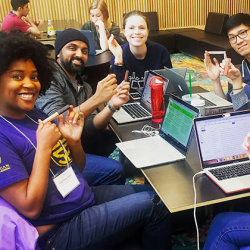Surviving to Thriving: Navigating the New World of Work

COVID undoubtedly thrust the overwhelming majority of people into a continuous state of survival mode, both in our personal lives and our professional lives.
After navigating through the COVID-19 pandemic and the impact it had on our lives, organizations and their employees emerging in this post-pandemic era face unlearning survival mode and shifting to now thriving in the new world of work. From hybrid and remote work to rapid digitalization, key trends shaping the new world of work have also influenced the ability to which people are able to thrive.
What does it mean to thrive
In the paper, A Socially Embedded Model of Thriving at Work, together with K. Sutcliffe, J. Dutton, S. Sonenshein, and A.M. Grant, we defined thriving as the psychological state in which individuals experience both a sense of vitality and a sense of learning at work. Thriving individuals feel positive and energized about their work, but the energy isn’t enough on its own; there is also the learning component where employees are growing by acquiring and applying new skills and trying new things. A sense of learning by itself isn’t sufficient either, as periods of intense learning and growth can even result in depleted energy in some instances; take Ph.D. students, for example. If you’re learning a lot but feeling burnt out, you’re not thriving, which is why a state of thriving must encompass both vitality and learning. In further work on thriving with K. Sutcliffe, we highlight the important aspect that thriving should be considered a continuum and that individuals can experience a range of thriving instead of merely experiencing either thriving or not thriving. Also important to consider is that an individual’s thriving is highly influenced and shaped by the context of their work.
Why thriving matters
Thriving in the workplace transcends just professional growth and explores a host of possible benefits for organizations and realms of holistic wellness and self-actualization for individuals. Varying studies have demonstrated that thriving individuals are more likely to be mentally and physically healthy and that thriving can positively impact mental and physical health conditions. These favorable effects on well-being also create implications for the relationship between thriving and individual and organizational performance. When employees feel more energized and experience improved well-being, there is often a correlation between improved productivity, increased initiative, and increased motivation to excel in their roles. And when employees have more opportunities to learn, they are more likely to use the new skills and knowledge gained to improve their performance. Both of these aspects have the potential to produce a ripple effect where someone who is energized can spread their energy to a unit and perhaps an entire energized organization, and someone who is learning can share their newfound knowledge with others to result in enhanced organizational learning. Thus, a work environment encouraging thriving can generate a positive and mutually beneficial cycle in which individual well-being fuels organizational success and vice versa.
Thriving in the new world of work
While the concept of thriving and why it’s important hasn’t changed, the new world of work brings implications for the ability to which people are able to thrive. Traditional work arrangements over the last century have often involved 40-hour work weeks performed on a fixed schedule and performed at an organization’s place of business, whether it be at an office, a factory, or any other place of work. This traditional work arrangement model is changing significantly today, with some aspects of it changing faster than others depending on the nature of the work people are doing. In the new world of work, we see three elements of flexibility that can either enrich the individual's thriving journey or impede it when organizations exercise control over flexibility to their advantage.
The first element of flexibility in the new world of work is flexibility in work contracts, i.e., how people work. Amidst the COVID-19 pandemic and resulting economic impacts, job security was eroded for many, with organizational downsizing and hiring freezes still seen in 2023. These actions exhibit flexibility but from the perspective of the organization. The organization wants the freedom and flexibility to choose when and where they hire talent and when they want to let it go. In reality, organizations today have created more flexible boundaries with work contracts; there is more temporary work, more contract work, and more non-standard jobs, and these non-standard jobs capture most of the net employment growth in recent years. Many workers today choose non-standard work or temporary arrangements instead of being forced into one as a result of not finding a standard job, highlighting the critical element of choice on the individual's part as opposed to the organization's.
The second element of flexibility in the new world of work is flexibility in work schedules, i.e., when people work. Rather than being expected to work the traditional 9-5 or 8-4 schedule, employees can choose to work during hours that accommodate their schedule and needs appropriately. This type of flexibility allows for better work-life balance management and benefits anyone who needs the flexibility to make a doctor’s appointment, pick up kids from school, meet a technician at home, or anything else that may have previously been unfeasible during traditional work schedules. On the other hand, it can be problematic when the flexibility of when people work is utilized only for the benefit of the organization. Consider a job that expects its employees to always be on call to come in. This expectation can be troublesome for employees who need to arrange childcare or employees who are students, and can overall impede the thriving experience.
The third and final element of flexibility in the new world of work is flexibility in work location, i.e., where people work. The shift in this flexibility was largely exacerbated by the COVID-19 pandemic and supported by rapid technological advancements. The capacity to work remotely, whether full-time or in a hybrid scenario, now holds substantial influence in job offer decisions made today. While there are potential negative outcomes of remote work, specifically feelings of isolation, that can adversely affect the thriving experience, thriving can primarily be enhanced by workplace location flexibility. One major benefit of work location flexibility is the reduction of commutes, which has historically been a highly prominent factor in low levels of job satisfaction. Other benefits of location flexibility are similar to those of schedule flexibility, largely related to work-life balance management, another critical component of job satisfaction and, ultimately, the thriving experience.
Together, these three dimensions of flexibility are highly influential on the thriving experience of workers today, with a critical distinction being whether the flexibility primarily serves the employee or the organization. For those fortunate enough to embrace this evolving landscape of work, where flexibility and autonomy have become the new normal, thriving has found more grounds to flourish. The concept of the traditional 9-to-5 workday confined within the walls of an office building has been challenged and, in many cases, replaced by flexible schedules, hybrid work, and a focus on a results-driven mindset. It is essential to acknowledge that not everyone in this new world of work experiences the same levels of thriving. Some may struggle with blurred boundaries between work and personal life that remote work can bring. Others may find it challenging to adapt to the fast-paced digital environment that remote work depends on. These challenges underscore the pivotal role organizations play in nurturing thriving by creating an environment that supports employee well-being, provides opportunities for learning and growth, and fosters a culture of flexibility and trust.
As is the new world of work, thriving remains a dynamic and evolving concept. Thriving is about finding vitality and learning even in the midst of change and uncertainty, as we have faced over the past few years and will undoubtedly continue to. As organizations and individuals continue to adapt to the challenges and opportunities of the post-pandemic era, thriving in the new world of work becomes not just a goal but a vital imperative for personal and professional success and fulfillment.
For readers interested in taking a deeper dive into strategies for thriving at work, I invite you to learn more about The Postive Leader program from Michigan Ross Executive Education.








